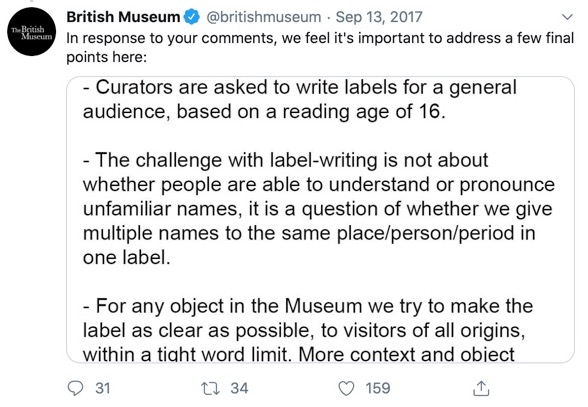III. #MuseumCrisis: Social Media in Museum Crisis Communications Plans
- Amy Pollard
Social media is changing the way institutions communicate with their publics, but how should museums communicate in times of crisis? Due to the instantaneous nature of social media, museums now face a landscape wherein an external or internal institutional crisis can lead to an immediate response from a very vocal online community. When a crisis situation arises, museums are now expected to use social media to swiftly respond and honestly communicate with online communities. In order to do this, the institution should have a comprehensive crisis communications plan that includes communicating via social media platforms. Ultimately, a crisis can be split into three phases—pre-crisis, mid -crisis, and post-crisis—each of which should be addressed by a comprehensive plan for the museum’s crisis communications. This paper will examine the various elements of an effective crisis communications plan, including establishing a social media plan, and demonstrating this plan in comparison to examples of successful social media usage in real-world institutional crises.
What is a Crisis?
Before identifying the phases of a crisis communications plan, the word “crisis” needs to be defined. There are three primary definitions of a crisis: situation-based crisis, sequential crisis, and stakeholder-based crisis. The situation-based definition addresses, “a threat to humans, animals, or values at the museum or as a threat to the museum’s reputation.”1 This definition focuses solely on the situation itself with no identification of the sequential nature of these types of events. A sequential definition addresses that events happen in succession, in which reasons are intertwined with results that lead to a loss of situation control and influence future trends.2 The sequential definition acknowledges both the crisis itself and the impact that a crisis has on an institution’s future. The situational and sequential definitions emphasize two very important aspects of a crisis, but both definitions are missing a crucial actor in institutions: the stakeholder.
For the purpose of this paper, the term “stakeholder” means any person who holds a vested interest in the museum. Stakeholders can be broken up into two groups: external and internal. External stakeholders define the organization’s reputation and act as a source of revenue for an organization, like donors, visitors, and the general public.3 Internal stakeholders are those who ensure the successful navigation of a crisis like museum staff and members of the board.4 With stakeholders in mind, a crisis can also be defined as, “an unpredictable event that threatens important expectancies of stakeholders and can seriously impact an organization’s performance and generate negative outcomes.”5 Museums operate for the benefit of the public, and the addition of stakeholders into the definition of crisis is crucial. With this in mind, this paper combines the three definitions above for a more nuanced definition of the term crisis. This new definition identifies a crisis as an unpredictable or anticipated situation, leading to a loss of situational control that threatens relationships with stakeholders and influences future trends in the institution.
In crisis situations, unresponsiveness via current technologies like social media can ultimately lead to a digital media crisis. Hilary-Morgan Watt, Digital Engagement Manager at the Hirshhorn Museum and Sculpture Garden, defines a digital media crisis as “any sudden and unpredictable online event, which provokes external scrutiny and is or has the potential to negatively impact operations, reputation, and relationships with internal and external stakeholders, employees and the community.”6 The digital media crisis definition shares the same elements of the above crisis definition but focuses on the crises that occur in digital environments like social media. Watt’s idea of digital media crisis works hand-in-hand with how museums should view their own role as communicators in times of crisis.
Crisis situations stem from a variety of sources: natural disasters, hiring decisions, contentious exhibitions or programming, financial downturn, etc. In order to successfully weather a crisis situation, an institution should create a crisis communications plan. The institutional crisis communications plan must be broad enough to act as a working document for any crisis event yet specific enough to define a comprehensive communications plan for the three phases of a crisis.
Crisis Communications Plan
In a perfect situation, institutions would have a comprehensive crisis communications plan in place long before the onset of a crisis. However, it is often the case that a crisis event acts as the catalyst for the development of a crisis communications plan. The following proposed crisis communications plan provides a layout based on the three crisis phases: pre-crises, mid-crisis and post-crisis. At the heart of this framework is a dedication to communicating quickly and honestly, as well as utilizing social media in a way that helps rather than hinders the museum’s interface with the public.
Pre-Crisis
In the pre-crisis phase, preparation and planning are important to successfully navigating future crises. In order to create a crisis communication plan, institutional leadership should assemble a team comprised of upper museum management, department heads, communications staff, and most importantly, the social media manager. The individual in the social media manager role is often a gateway to the various stakeholders and is a crucial communicator in times of crisis.7 Despite the important and demanding work completed by the social media manager, oftentimes they are not valued as an integral part of these crisis communications teams. As the staff person who interfaces the most with online stakeholders and conveys the everyday institutional tone to the museum’s online publics via social media, it is essential that the social media manager be included in all crisis planning meetings and be an integral part of the crisis communications team.
During the planning meeting with the above staff members, this group must identify the museum’s various stakeholders. Understanding stakeholders and their communication needs is the first step in crafting a plan for crisis response.8 For example, most internal stakeholders will need to be informed of the crisis situation via email or telephone independently of social media, website posts, or news sources. During this planning meeting, the team needs to determine notification systems for internal stakeholders.9 Deeply invested internal stakeholders can help with shaping the message, but in order to do so, they must be kept informed of the situation, as well as plans for navigating the crisis.10
An institution’s external stakeholders will most likely be comprised of several smaller stakeholder groups, each of whom may use social media platforms differently, depending on demographics. There are many factors that shape an individual’s social media use, including age, “race”/ethnicity, education, economic status and cultural background. However, user age often suggests platform preference. According to the PEW Research Center breakdown of social media usage by age demographic, 55 percent of adults ages 50 and older use Facebook and 56 percent use Youtube. However, only 16 percent of this age group use Instagram and 14 percent use Twitter.11 On the other end of the age demographic spectrum, the PEW Research Center found that 80 percent of adults ages 18-24 use Facebook, 71 percent of this age group are on Instagram, and 45 percent of this age group are on Twitter. Based on these figures, social media communications via Facebook are more likely to reach a wider variety of age groups, whereas communications via Instagram and Twitter will reach mostly younger social media users under 50 years of age. It is in the best interest of the planning committee to make a comprehensive plan for each social media platform utilized by the museum, with the intention of communicating crisis messaging to a broader range of external stakeholders.12
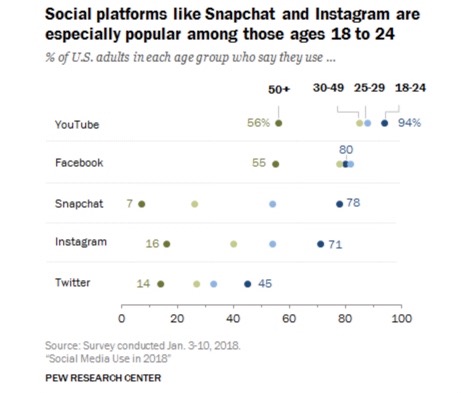
This pre-crisis phase is also the ideal time to decide the institutional voice that will be used in the event of a crisis. Institutional voices used in regular social media communications range from informal, humanized voices to formal and academic. Retaining a consistent voice on social media platforms can be an essential part of developing a relationship with the museum’s publics built on trust. The social media manager develops and often acts as the trusted voice of the institution and carries these responsibilities into crisis communications.13 It is worth noting that many institutions have multiple contributors to social media platforms, and maintaining a consistent voice becomes more crucial, especially when institutions find themselves in a crisis situation. In planning an institutional voice for a crisis , this incident, the planning team needs to determine a voice that reflects the institution and continues to build trust with online communities. Planning for the institutional voice in a time of crisis also involves understanding the types of language and interactions that occur on the various social media platforms. The social media manager is again instrumental in this conversation, as they should have the most knowledge about the intricacies of interacting with external stakeholders on each platform. Establishing a plan for the crisis institutional voice, as well as having a full understanding of the proper language used on these platforms will ultimately lead to more decisive and consistent communications with stakeholders in times of crisis.
The crisis communications planning team described above should also establish the staff members that will be a part of the crisis response team. This team will be the first line of defense in monitoring crisis situations and will be actively crafting the museum’s responses over social media and other outlets like the museum’s website. Ideally, this group should be comprised of three or four museum staff members with the chief executive making the decisions.14 Like the crisis communications planning team, this crisis response team must include the social media manager, as well as the head of communications, as both of these individuals will be monitoring platforms, crafting messaging, and responding via the institution’s social media accounts. Although typically supervised by the head of communications, the social media manager should always be included in the crisis response team. Depending on the situation, a fourth staff member should also be included in the crisis response team. For example, in the event that controversial programming causes a crisis situation, the crisis response team should most likely include the director of the education department. Whereas, in a financial crisis situation, the head of finances should be part of the crisis response team. To reiterate, each situation will warrant different expertise, but the crisis response team should always include the director of the institution, the head of communications, and the social media manager.
Lastly, the pre-crisis phase includes actively monitoring social media accounts for mentions of impending crisis events that will warrant a response from the institution. As stated by Jonathan Bernstein, “Failure of organizations to anticipate and prevent potential crises is a rampant crisis of its own.”15 Anticipating a crisis event will depend on the type of situation. For example, in anticipation of a controversial exhibition, the social media manager may be actively monitoring for backlash from online stakeholders. By contrast, in the event of a natural disaster, the social media manager will have very little warning before an institutional response is needed. Most importantly, in monitoring for a crisis, the social media manager must look for certain indicators that warrant a response from an institution. Hilary-Morgan Watt created a checklist that can be adapted to monitoring for potential crises during this phase.16 In the event that more than one of these checklist items can be checked in the “Crisis Yes” category, the social media manager should bring this incident directly to the crisis planning committee, who will activate the crisis response team. From this point, the crisis response team should move into the mid-crisis phase and focus on active communication with stakeholders.
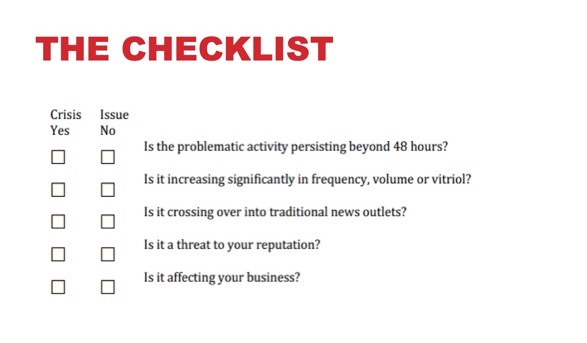
In 2018, the Brooklyn Museum in New York City hired white curator, Dr. Kristen Windmuller-Luna, as a consulting curator of African Art. The institution received criticism from external, online stakeholders for hiring a white curator of African art. Online protests began on March 27th on Twitter, Facebook, and Instagram, with many stakeholders on these platforms including the hashtag #africansforafricanart on the museum’s posts.17 Two days later, the Brooklyn Museum responded via Twitter (pictured below)18 and Facebook with a prepared statement that highlighted the museum’s commitment to listening to the conversations being had on social media and the museum’s continued emphasis on equity.19
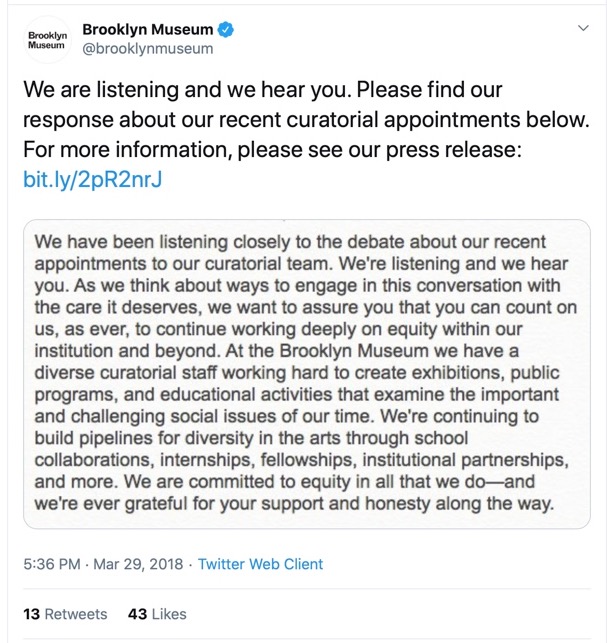
The institution’s quick response on March 29, 2018 highlights the social media manager’s vigilance in monitoring the museum’s posts and tags and anticipating backlash from online stakeholders. The museum’s situation corresponded with several items on Watt’s checklist. The museum responded after 48 hours passed, indicating that the issue persisted past the 48-hour mark. Negative social media posts increased in frequency and vitriol and the issue began to reach news outlets. Lastly, the museum’s reputation was at stake, eventually resulting in the Director Anne Pasternak’s response during the mid-crisis phase, in which she “unequivocally” stood by the museum’s decision to hire Dr. Windmuller-Luna.20 Despite the negative responses from the public, the institution worked quickly to mitigate additional tensions with online stakeholders by actively monitoring responses during the pre-crisis phase and responding accordingly.
Mid-Crisis
The mid-crisis phase relies on both effective institutional operations and quick social media responses from the crisis response team. During this phase, the museum’s crisis response team should immediately prioritize containment of the damage. Internally, the crisis communications team must first decide the scope of the problem, including identifying whether this is a self-made issue or an external issue like a natural disaster.21 The crisis response team may already be aware of a self-made issue if the social media manager was monitoring social media and anticipating negative online responses. The response team must also designate a spokesperson who will act as the face of the institution. This person will typically be the museum director who can speak to decision-making during the incident and moving forward from the incident. Again, the social media manager is instrumental in this phase, as they will act as the digital spokesperson and interface often with online stakeholders. Finally, the crisis response team also needs to be in constant contact with each other, as well as continually updating pertinent internal stakeholders as the crisis event unfolds.
After pinpointing the problem, the social media manager and crisis response team should craft a first response that is both straightforward and decisive.22 The institution’s first response will set the tone for the rest of the crisis. Due to the reactive nature of social media, museum responses need to address issues and update the public in a timely manner. A slow response may lead to an increased divide between the institution and stakeholders. Generally, short form media like Twitter, Facebook, Instagram, and Tumblr allow the institution to best address stakeholders with concise messaging.23
For example, the J. Paul Getty Museum in Los Angeles was in the direct path of a brush fire on October 28, 2019. The museum’s first Twitter24 and Facebook25 responses to online stakeholders were posted at 7:02 a.m. The Getty’s Twitter response effectively utilized the platform’s word limit to post a clear and concise message that conveyed the serious threat of a fire, the activation of emergency operations, and a promise to provide updates. In comparison, the institution utilized Facebook’s lack of a word limit to continue updating the Getty’s status throughout the events of October 28, 2019. The social media manager also incorporated the #GettyFire hashtag in the very first posting and all subsequent postings. This was particularly important for keeping track of this thread, especially on Twitter. Overall, the Getty’s messaging during this crisis event was consistent between these two platforms and effectively communicated the museum’s status from the very first post.

After the initial online communication, the social media manager should continually monitor all social media accounts and news outlets, even outside of the normal 9-to-5 hours of the typical workday. As events unfold, the social media manager should use the previously agreed upon institutional voice to monitor and respond to real-time social media comments when appropriate. Carefully crafted responses allow for increased museum transparency. Social media gives the public the ability to see behind closed doors and further connects the museum to its stakeholders.26 Often stakeholder comments will include questions, and the social media manager should only answer them if they feel they can have a constructive conversation. For example, during the Getty Fire the social media manager responded to several Twitter users who asked about the Getty Center and Villa’s fire preparedness27. Seeing the potential for a learning opportunity in the midst of crisis, the social media manager linked to an article that described the museum’s state-of-the-art system, while still maintaining a conversational and approachable voice. This response showcases the museum’s consistent institutional tone yet continued emphasis on actively engaging with the public through informative conversation.

Through the process of monitoring social media platforms, the social media manager will have the important task of acting as the digital spokesperson who provides updates and clarifications to further mitigate alienating stakeholders.28 This can be done on social media platforms by continuously updating the original post or creating new posts. Depending on the crisis event, providing clarifications to a misstatement might be best done through one continuous post, whereas creating short updates on new posts may be better for a natural disaster crisis event. The social media manager, as well as the other crisis response team members have the duty to make the best decision for crisis containment based on the circumstances of the situation.
On September 13, 2017, British Museum’s Keeper of Asia Curator, Jane Porter, took to Twitter on Ask a Curator Day to answer questions about her curatorial process. When asked about designing exhibition labels and accessible information, she responded by saying, “…We aim to be understandable by 16 year olds. Sometimes Asian names can be confusing, so we have to be careful about using too many.”29 Porter adds two additional clarifications to this same post before signing off. The social media manager then addresses the same thread twice more to further clarify Porter’s meaning in her Ask a Curator session30. In providing this Twitter thread in one place, the museum’s social media manager was better able to address the issues in context of the original tweet.
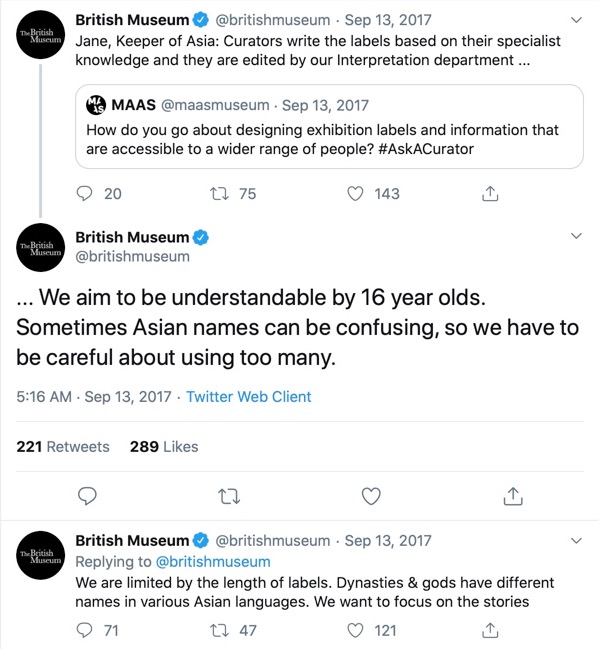
Social media is 24/7 and doesn’t stick to normal office hours.31 The day-to-day job of the social media manager can cause burnout, or a state of mental, emotional, and physical exhaustion caused by prolonged stress.32 This state of burnout can exist long before the onset of a crisis. However, the act of constantly being online, paired with the vulnerabilities of the position during a crisis event can put the social media manager at an increased risk of this phenomenon. During a time of crisis, the social media manager and other members of the crisis response team need to be vigilant for signs that the social media manager is experiencing burnout. Burnout can appear as ambivalence, emotional exhaustion, and/or depersonalization.33 In these instances, staff should focus on providing physical and emotional support through temporarily assisting with crisis responses or possibly providing a safe space to talk and decompress. Eventually, the crisis will end, and the institution will transition into the post-crisis phase. However, the social manager will return to the typical workday, still be plagued with the potential for social media burnout even after the crisis has ended.
Post-Crisis
The aftermath of a crisis, or the post-crisis phase, will be a time for the institution to reflect on its responses over the course of the event. For continued transparency with the public, institutions should use long-form media like blogs and wikis to publish analyses of the crisis event. In these long-form media sources, institutions can admit weaknesses and lessons learned from the crisis event.34 This increased transparency of the museum’s successes or failures allows for relationship building with existing or even new stakeholders.
Beyond using long-form media sources, the social media manager should also continue to use short-form media sources as a way to communicate the museum’s plans moving forward from the event. It is important to remind stakeholders that institutionally the museum is making progress moving forward from the crisis event.35 Periodically reminding stakeholders of improvements also further helps to rebuild the museum’s reputation, particularly after a self-made crisis event. The social media manager should still remain an integral part of the post-crisis communications phase, continuing to use the institutional voice to seamlessly create content that engages the public yet rebuilds relationships with stakeholders.
The Walker Art Center in Minneapolis, MN acquired artist Sam Durant’s sculpture Scaffold (2012) in 2014 and exhibited this piece in the Walker sculpture garden in 2017. Depicting gallows that recall the hanging of the Dakota 38 in 1862, this piece caused outcry and protests from external stakeholders for its trivialization of a traumatizing event in Dakota history.36 In conversation with members from the Dakota community, Sam Durant, the Walker Art Center, and the Minneapolis Park and Recreation Board, it was decided that Scaffold would be removed and ceremoniously burned by members from the community. The Walker’s then executive director, Olga Viso recognized the institutional need to rebuild trust with native communities following this crisis.37 In the post-crisis phase, the Walker Art Center continued to keep external stakeholders updated with its attempts to rebuild relationships with native communities. In July 2018, the museum posted on its Twitter platform38, announcing that the institution formed a committee to find an indigenous artist who will create a new piece for the sculpture garden. It is important to note that the institution provided an update a year after the crisis event, showing that the museum is continuing to make an institutional shift in relations between the Walker Art Center and its external stakeholders. Updates via short-form media like this should be actively utilized in the post-crisis phase. This ultimately aids in crucial relationship rebuilding in the aftermath of the crisis.
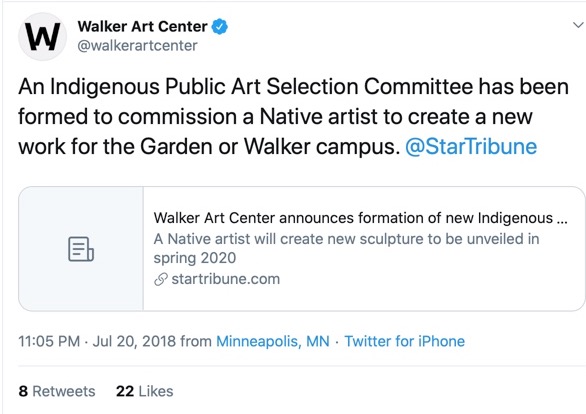
Institutionally, as part of processing the crisis event, the crisis communications planning team should reevaluate the crisis communications plan based on the events of the most recent incident. This analysis should occur in the week following a crisis, while the staff still has the event and responses clearly in their memories. The crisis communications plan is a living document and should be kept up to date with new best practices or updates to communication technologies. Ultimately, the post-crisis phase allows for the most institutional self-reflection and any necessary changes made to the crisis communications plan will ultimately leave the museum with a better plan for future crises.
Conclusion
“Plan as if you live in a transparent world. Because you do.”39 Institutions must live by this idea, especially when planning for future crisis events. No matter the crisis incident, institutions should create comprehensive crisis communications plans that involve communicating through online resources like social media. The three phases of a crisis—pre-crisis, mid-crisis, and post-crisis—are equally important to the stages of a crisis. Pre-crisis should determine how the museum will stay on top of the messaging, the mid-crisis stage should determine the relationship with online stakeholders, and the post-crisis phase should determine the museum’s institutional changes moving forward, as well as future crisis communications plans. Ultimately, the crisis communications plan is a living document that should change with each crisis event and updates to social media technology. Social media platforms change constantly, and the institution needs to be well-equipped to weather the storm of controversy by having an effective communication plan in place. Consistent and open communications with stakeholders will ultimately allow for increased transparency and trust between an institution and its stakeholders.
Notes
- Linea Hanson and Ida Nordentoft Gustav, “Crisis Management and the Digital,” In Museums and the Web, edited by N. Proctor & R. Cherry, Silver Spring, MD: September 30, 2013. https://mwa2013.museumsandtheweb.com/paper/crisismanagement/. ↩
- Idriss Lekrini as quoted in Guembour Abderraouf and Raki Nadira, “Role of Communication and Technology in Crisis Management,” European Journal of Science and Engineering 1, no. 2 (2018): 39. https://pdfs.semanticscholar.org/08d1/2af844886d64ff969fb1d9c4d8d2fd7d70dd.pdf. ↩
- Abderraouf and Nadira, “Role of Communications and Technology in Crisis Management,” 40. ↩
- Abderraouf and Nadira, “Role of Communications and Technology in Crisis Management,” 40. ↩
- W.T. Coombs as quoted in Yang Chen, “How Social Media Is Changing Crisis Communication Strategies: Evidence from the Updated Literature,” Journal of Contingencies & Crisis Management 26, no. 1 (2018): 59. https://doi.org/10.1111/1468-5973.12130. ↩
- Hillary-Morgan Watt, “Crisis Communications in a Digital World,” Lecture, Museums & Social Media, George Washington University, Washington, DC, Spring 2019. ↩
- Lori Byrd-McDevitt, “The Great Social Media Manager Exodus,” Medium, August 7, 2019. https://medium.com/@LoriLeeByrd/the-great-museum-social-media-manager-exodus-b5cd259856a3. (accessed October 15, 2019). ↩
- Chen, “How Social Media is Changing Crisis Communication Strategies,” 65. ↩
- Watt, “Crisis Communications in a Digital World.” ↩
- Tim Hallman, “When You’re Under Fire: A Step-By-Step Guide For Creating A Comprehensive Crisis Communications Plan,” American Alliance of Museums, May 1, 2018. https://www.aam-us.org/2018/05/01/when-youre-under-fire-a-step-by-step-guide-for-creating-a-comprehensive-crisis-communications-plan/. (accessed September 14, 2019). ↩
- “Social Platforms Like Snapchat And Instagram Are Especially Popular Among Those Ages 18 To 24,” Pew Research Center, February 27, 2018. https://www.pewresearch.org/internet/2018/03/01/social-media-use-in-2018/pi_2018-03-01_social-media_0-02/. (accessed November 10, 2019). ↩
- It is worth noting that social media crises can also arise on a platform not used by the institution. The museum can truly never plan for this kind of crisis when it happens. ↩
- Russell Dornan, “Should Museums Have a Personality?” Medium, March 9, 2017. https://medium.com/@RussellDornan/museumpersonality-87ab2112ee9e. (accessed October 20, 2019). ↩
- Hallman, “When You’re Under Fire.” ↩
- Jonathan Bernstein, “Crisis Prevention and Planning,” Bernstein Crisis Management. https://www.bernsteincrisismanagement.com/portfolio-item/crisis-prevention/. (accessed November 3, 2019). ↩
- Watt, “Crisis Communications in a Digital World.” ↩
- Brooklyn Museum, 2018, “The Burghers of Calais Post,” Instagram photo, March 28, 2018, https://www.instagram.com/p/Bg3uRJ6F2Ro/ ↩
- Brooklyn Museum (@brooklynmuseum), 2018, “Curatorial Appointment Post,” Twitter, March 29, 2018, 5:36 p.m. https://twitter.com/brooklynmuseum/status/979472489398132738. ↩
- Brooklyn Museum (@brooklynmuseum), 2018, “Curatorial Appointment Post,” Twitter, March 29, 2018, 5:36 p.m. https://twitter.com/brooklynmuseum/status/979472489398132738. ↩
- Anne Pasternak, 2018. “Brooklyn Museum.” Tumblr, April 6, 2018. https://brooklynmuseum.tumblr.com/post/172660670602/dear-friends-in-light-of-recent-conversations-i. ↩
- Hallman, “When You’re Under Fire.” ↩
- “Museum Best Practices for Managing Controversy,” National Coalition Against Censorship, Accessed September 14, 2019. https://ncac.org/resource/museum-best-practices-for-managing-controversy. ↩
- Rachel Gonzalez, “Keep the Conversation Going: How Museum’s Use Social Media to Engage the Public” The Museum Scholar 1, No. 1, 2017. http://articles.themuseumscholar.org/vol1no1gonzalez. ↩
- Getty Museum (@GettyMuseum), 2019, Getty Fire Post,” Twitter, October 29, 2019, 7:02 a.m. https://twitter.com/GettyMuseum/status/1188772948200394753. ↩
- Getty Museum, 2019, “Getty Fire Post,” Facebook, October 28, 2019, https://www.facebook.com/gettymuseum/posts/10157725259185097?__ ↩
- Rachel Gonzalez, “Keep the Conversation Going: How Museums Use Social Media to Engage the Public,” The Museum Scholar 1, no. 1 (2017), http://articles.themuseumscholar.org/vol1no1gonzalez. (accessed September 14, 2019). ↩
- J. Paul Getty Museum (@GettyMuseum), “Getty Response to Online Stakeholder,” Twitter, October 28, 2019, https://twitter.com/GettyMuseum/status/1188878282881585152. ↩
- Watt, “Crisis Communications in a Digital World.” ↩
- British Museum (@britishmuseum), 2017, “Ask a Curator Twitter Post,” Twitter, September 13, 2017, 5:16 a.m. https://twitter.com/britishmuseum/status/907895752822751233?ref_src=twsrc%5Etfw%7Ctwcamp%5Etweetembed%7Ctwterm%5E907895752822751233&ref_url=https%3A%2F%2Fnews.artnet.com%2Fart-world%2Fbritish-museum-asian-names-tweet-1080563. ↩
- British Museum (@britishmuseum), 2017, “Ask a Curator Twitter Post,” Twitter, September 13, 2017, https://twitter.com/britishmuseum/status/907895752822751233?ref_src=twsrc%5Etfw%7Ctwcamp%5Etweetembed%7Ctwterm%5E907895752822751233&ref_url=https%. ↩
- Russell Dornan, “Social Media Burnout.” ↩
- Bo Han. “Social Media Burnout: Definition, Measurement Instrument, and Why We Care,” Journal of Computer Information Systems 58, no. 2 (2016): 122. https://doi-org.proxygw.wrlc.org/10.1080/08874417.2016.1208064. ↩
- Han, “Social Media Burnout: Definition, Measurement Instrument, and Why We Care,” 124. ↩
- Abderraouf and Nadira, “Role of Communications and Technology in Crisis Management,” 40. ↩
- Hallman, “When You’re Under Fire.” ↩
- Sarah Cascone, “Walker Art Center’s Controversial Gallows Sculpture Will Be Removed and Ceremonially Burned,” Art World. Artnet News, May 31, 2017. https://news.artnet.com/art-world/walker-sculpture-garden-to-remove-sam-durant-scaffold-977447. (accessed November 10, 2019). ↩
- Cascone, “Walker Art Center’s Controversial Gallows Sculpture Will Be Removed and Ceremonially Burned.” ↩
- Walker Art Center (@walkerartcenter), “Walker Art Center Formed Commission to Find Native Artist,” Twitter, July 20, 2018, 11:05 p.m., https://twitter.com/walkerartcenter/status/1020504906254495744. ↩
- Hallman, “When You’re Under Fire.” ↩



